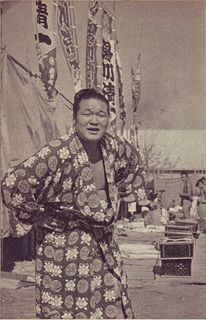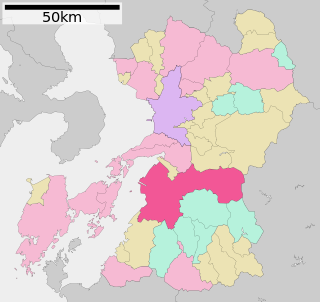Daizen Takahiro is a former sumo wrestler from Osaka, Osaka, Japan. He made his professional debut in March 1981, and reached the top division in November 1991. His highest rank was komusubi and he earned two kinboshi. After his retirement in 2003 he became an elder in the Japan Sumo Association and a coach at Nishonoseki stable. Upon the closure of his stable in 2013 he moved to Kasugano stable.
Masudayama Yasuhito is a former sumo wrestler from Nanao, Ishikawa, Japan. He made his professional debut in March 1974, and reached the top division in November 1976. His highest rank was sekiwake. He retired in July 1989 and became an elder in the Japan Sumo Association under the name Chiganoura. He was the oldest man in any of the professional sumo divisions at the time of his retirement. He set up Chiganoura stable in 2004 at the age of 53, after he was passed over for the head coach position at Kasugano stable the previous year. He retired upon reaching 65 years of age in April 2016, but was re-employed by his stable as a consultant.

Wakachichibu Komei was a sumo wrestler from Chichibu, Saitama, Japan. He made his professional debut in May 1954 and reached the top division in September 1958. His highest rank was sekiwake. Upon retirement from active competition he became an elder in the Japan Sumo Association, under the name Tokiwayama. He reached the Sumo Association's mandatory retirement age in March 2004.
Shiratayama Hidetoshi is a former sumo wrestler from Kagami, Kumamoto, Japan. He made his professional debut in September July 1959 and reached the top division in March 1971. His highest rank was maegashira 4. Upon retirement from active competition he became an elder in the Japan Sumo Association, under the name Tanigawa. He reached the Sumo Association's mandatory retirement age in December 2008.
Harunoyama Tatsunao is a former sumo wrestler from Toyota, Aichi, Japan. He made his professional debut in March 1992 and reached the top division in March 2004. His highest rank was maegashira 10. Upon retirement from active competition he became an elder in the Japan Sumo Association, under the name Takenawa. He left the Sumo Association in January 2008.
Asasegawa Takeya is a former sumo wrestler from Naniwa-ku, Osaka, Japan. He made his professional debut in May 1957 and reached the top division in March 1964. His highest rank was maegashira 1. Upon retirement from active competition he became an elder in the Japan Sumo Association under the name Urakaze. He left the Association in January 1975.
Tokitsunada Hironori was a sumo wrestler from Waki, Tokushima, Japan. He made his professional debut in March 1985, and reached the top division in May 1992. His highest rank was maegashira 4. He retired in September 1999 and remained in the Sumo Association as jun-toshiyori. He had to leave the Sumo Association in September 2001, having failed to acquire a permanent toshiyori. He was the first jun-toshiyori wrestler to be forced to leave sumo in this way. However he later worked in a private capacity as a coach at Arashio stable. He also ran a chanko restaurant named Tokitsunada in Tokyo.
Wakafutase Tadayuki, born Tadateru Tojima, was a sumo wrestler from Nagoya, Aichi, Japan. He made his professional debut in September 1960, and reached the top division in March 1966. His highest rank was komusubi. Upon retirement from active competition he became an elder in the Japan Sumo Association. He took over as a head coach at Asahiyama stable in October 1975 and died while still an active oyakata. He was succeeded as head coach by former ōzeki Daiju.
Kotogatake Koichi is a former sumo wrestler from Teshikaga, Hokkaidō, Japan. He made his professional debut in November 1967 and reached the top division in July 1976. His highest rank was maegashira 1. Upon retirement from active competition he became an elder in the Japan Sumo Association. He left the Sumo Association in March 1995.
Asanobori Toshimitsu is a former sumo wrestler from Yubari, Hokkaidō, Japan. He made his professional debut in July 1963 and reached the top division in March 1969. His highest rank was maegashira 2. Upon retirement from active competition he became an elder in the Japan Sumo Association. He left the Sumo Association in June 1979.
Daimonji Kenji is a former sumo wrestler from Kyōto, Japan. He made his professional debut in March 1956 and reached the top division in November 1966. His highest rank was maegashira 5. Upon retirement from active competition he became an elder in the Japan Sumo Association, under the name Nishiiwa. He coached at Taihō/Ōtake stable, until reaching the Sumo Association's mandatory retirement age of 65 in February 2005.

Oiteyama Hirokuni, born Mitsugu Yamaguchi, was a sumo wrestler from Goshogawara, Aomori, Japan. He made his professional debut in May 1953 and reached the top division in May 1960. His highest rank was maegashira 6. Upon retirement from active competition he became an elder in the Japan Sumo Association. He reached the Sumo Association's mandatory retirement age of 65 in June 2003.
Tochiōyama Yuki was a sumo wrestler from Nagoya, Aichi, Japan. He made his professional debut in November 1958 and reached the top division in March 1963. His highest rank was maegashira 1. Upon retirement from active competition he became an elder in the Japan Sumo Association under the name Kiyomigata. He left the Sumo Association in October 1976.
Chiyozakura Teruo is former a sumo wrestler from Imakane, Hokkaidō, Japan. He made his professional debut in March 1966, and reached the top division in September 1976. His highest rank was maegashira 5. Upon retirement from active competition he became an elder in the Japan Sumo Association under the name Fujigane. He left the Sumo Association in March 1979.
Kairyūyama Teruhisa was a sumo wrestler from Shōwa, Akita, Japan. He made his professional debut in March 1956 and reached the top division in July 1960. His highest rank was sekiwake. He won eight gold stars against grand champion yokozuna in the course of his career. Upon retirement from active competition he became an elder in the Japan Sumo Association under the name Kiriyama. He left the Sumo Association in December 1980.
Hidanohana Shigeyoshi is a former sumo wrestler from Asahi, Gifu, Japan. He made his professional debut in March 1969 and reached the top division in September 1980. His highest rank was maegashira 1. Upon retirement from active competition he became an elder in the Japan Sumo Association under the name Onoe. He left the Sumo Association in March 1994.
Yoshioyama Osamu is a former sumo wrestler from Yatsushiro, Kumamoto, Japan. He made his professional debut in March 1965 and reached the top division in November 1969. His highest rank was maegashira 2. Upon retirement from active competition he became an elder in the Japan Sumo Association under the name Onogawa. He left the Sumo Association in January 1977.
Aonosato Sakari was a sumo wrestler from Kuraishi, Aomori, Japan. He made his professional debut in March 1953, and reached the top division in January 1959. His highest rank was sekiwake. Upon retirement from active competition he became an elder in the Japan Sumo Association under the name Hatachiyama. In 1988 he took over as head coach at Tatsutagawa stable from former yokozuna Kagamisato and became Tatsutagawa-oyakata. Two months prior to reaching the Sumo Association's mandatory retirement age of 65 in November 2000, Tatsutagawa stable was shut down and the remaining wrestlers transferred to Michinoku stable.
Hagurohana Toji was a sumo wrestler from Nishiokoppe, Hokkaidō, Japan. He made his professional debut in September 1955, and reached the top division in September 1960. Upon retirement from active competition he became an elder in the Japan Sumo Association under the name Onaruto and later Tamagaki. He left the Sumo Association in October 1972.
Taketora is a masculine Japanese given name. Notable people with the name include:





